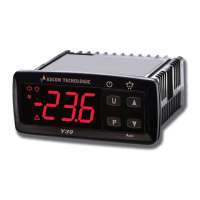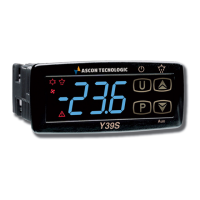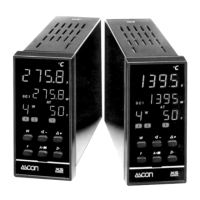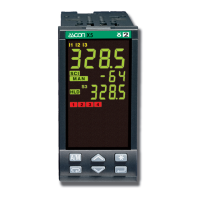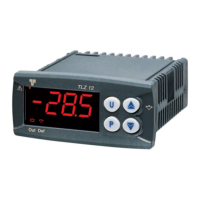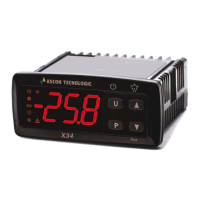ASCON TECNOLOGIC - Y39E - OPERATING INSTRUCTIONS - Vr. Mondial Group - 10/10 - ISTR-MY39EENGmondial - PAG. 6
The differential is automatically considered by the regulator with
positive values for the Coolig Action or with negative values for the
heating action.
off
Out
Out
(ot)
(HE)
off
0N
SP
Pr1
Temp.
off
0N
r.d
r.d
time
0N
off
All time protections described in the next paragraph (P.P1, P.P2,
P.P3) always act only on the output configured as “ot”.
In the event of probe error, it is possible to set the instrument so
that that the output “ot”continues to work in cycles according to the
times programmed in the parameter “r.t1” (activation time) and
“r.t2” (deactivation time).
If an error occurs on the probe the instrument activates the output
for the time “r.t1”, then deactivates it for the time “r.t2” and so on
whilst the error remains.
Programming “r.t1” = oF the output in probe error condition will
remain switched off.
Programming instead “r.t1” to any value and “r.t2” = oF the output
in probe error condition will remain switched on.
Remember that the temperature regulation function can be
conditioned by the “Compressor Protection and output delay at
power-on”, “Defrost”, “Door open” and “external alarm with outputs
disable” functions.
4.7 - COMPRESSOR PROTECTION FUNCTION AND DELAY AT
POWER-ON
The function “Compressor Protection” aims to avoid close start ups
of the compressor controlled by the instrument in cooling
applications.
This function foresees 3 time controls on the switching on of the
output configured as “ot” associated with the temperature
regulation request.
The protection consists of preventing the output being switched on
during the times set in the parameters “P.P1”, “P.P2” and “P.P3”
and therefore that any activation occurs only after all the times has
finished.
First control (par. “P.P1” ) foresees a delay to the output activation
(switching-on delay).
Temp.
off
ON
SP
time
r.d
off off off
ON ON
Pr1
Out
(ot)
Second control (par. “P.P2” ) foresees an inhibition to the
activation of the output by a time delay that starts when the output
is turning off (delay after switching-off).
ON
off
P.P2
P.P2 P.P2
SP
Tem p.
tim e
r.d
ON ON
off off
Pr1
Out
(ot)
Third control (par. “P.P3” ) foresees an inhibition to the activation
of the output "Out" by a time delay that starts when the output was
turning on last time (delay between switching-on).
P.P3
off
SP
ON
Temp.
P.P3 P.P3
time
r.d
off off
ON ON
Pr1
(ot)
Out
During the output inhibition the led OUT (Cool o Heat) blinking.
It is also possible to prevent activation of the output after the
instrument is turned on, for the time set in the parameter “P.od”.
During the power on delay phase, the display shows the indication
od, alternating with the normal visualisation.
All the functions are disabled by relative parameters = oF.
4.8.1 - AUTOMATIC DEFROST STARTS
The automatic control of defrost occours:
- By interval times (regular or dynamic)
- By Evaporator temperature
- By continuous compressor running time
Defrost by regular interval time
The automatic defrost function is activate when at the parameter
“d.di” is set the defrost interval time.
The first defrost after swiching on can be set by par. “d.Sd”
This allows to perform the first defrost to a different interval from
"d.di." time.
If it is desired that to every instrument power on a defrost cycle is
realized (as long as the conditions set in the parameters “tS” and
"tE" apply) program the par. "d.Sd" = oF.
This allows the evaporator to be permanently defrosted, even when
frequent interruptions to power supply occur that may cause the
cancellation of the various defrosting cycles.
Instead if is desired all defrost to the same interval program "d.Sd"
= "d.di."
Automatic defrost function by interval is disable when “d.di” = oF.
“Dynamic Defrost Intervals System”.
If “d.dd” = 0 the Dynamic defrost is disable.
Note: For this function is necessary to use the evaporator probe.
This mode allows to dynamically reduce in progress the defrost
interval counting ("d.di" or "d.Sd" if is the first defrost), anticipating
so the execution of a defrost when it was necessary, in order to an
algorithm that allows to notice a decrease performances of
refrigerator thermal exchange.
Besides it maintains activates the mode "St" that it allows a further
possibility of control of the defrost in order to notice a decrease
performances of refrigerator thermal exchange.
The algorithm allows to esteem a reduction of thermal exchange in
base to the increase of the difference of temperature between Pr1
(controlled temperature) and evaporator (“EP” probe) that is
memorized by the instrument in proximity of the Set Point.
The advantage of the “Dynamic Defrost Interval” is the possibility to
program a defrost interval time more longer than normal.
The instrument will have the possibility to anticipate the defrost if
necessary or to start the cycle after the programmed time.
If the system results set correctly is possible to to avoid many non
necessary defrosting cycles (and therefore to obtain an energy
saving) that could instead happens in the normal operation when,
to guarantee with greater certainty the system efficency , the
defrost interval is programmed at a too low time.

